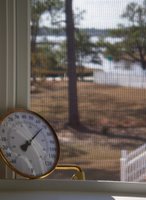 We actually had a cold streak of weather last week down here on the North Carolina coast. As I was getting ready to mount a thermometer outside one of the windows, I happened to come into my upstairs office. The sun felt like spring so I opened the window and set the thermometer in the corner. It didn't take long to come up from the downstairs temperature of sixty-five. Since I took the picture it has risen close to eighty degrees.
We actually had a cold streak of weather last week down here on the North Carolina coast. As I was getting ready to mount a thermometer outside one of the windows, I happened to come into my upstairs office. The sun felt like spring so I opened the window and set the thermometer in the corner. It didn't take long to come up from the downstairs temperature of sixty-five. Since I took the picture it has risen close to eighty degrees.The challenge of keeping cool in the winter is lot easier to handle than the challenge of keeping warm. I was thinking recently of how cold I was in December during a couple of trips to NY City and Montreal.
The city streets seem to amplify the cold. Once the giant buildings get cold, it takes a lot of heat to warm them. In the winter they radiate cold while they often prevent the suns warming rays from reaching the ground. Here in the country we're more at the mercy of the weather. The large bodies of water nearby tend to moderate the temperatures, but once they get cold they also take a long time to get warm.
You often hear about how the pace of life here on the coast enables even the most harried city person to relax. Our open spaces and relaxed way of life might also ameliorate a population trend that cities seem to enhance. I read this in a post, "Bigger Cities, Fewer People," by Stephen Johnson.
Demographers now believe that the earth’s population will peak in the middle of this century, at somewhere around 8 billion people, and then start decreasing.While we often hear about the stress that our planet is under, we rarely hear about things coming into equilibrium. One of the most interesting things that has happened this century is the reforestation of the eastern United States. According to this USGS article ninety percent of the Northeast was covered with forest in 1700. That number had dropped to thirty percent by 19oo. Today the number has recovered to eighty percent. At the same there is something of a trend in the US for people to move to low density spaces. I suspect there is another trend for some folks to move to city cores.
Cities turn out to be a driving force behind that correction. Keep in mind that we have shifted, in just two centuries, from a planet where 3 percent of people lived in cities to a planet where 50 percent of us do. When people move to cities, they have significantly fewer children for several reasons: women tend to work, birth control is more readily available, and space limitations make children an economic liability.
I wonder if any of the movement out of the cities will slow the drop in the birth rate. Perhaps the reasons for many children outside a city are no longer there. In fact the more children you have, the more trips you have to make to the city. I wonder if suburban family sizes are smaller or larger than those in the city?
No comments:
Post a Comment